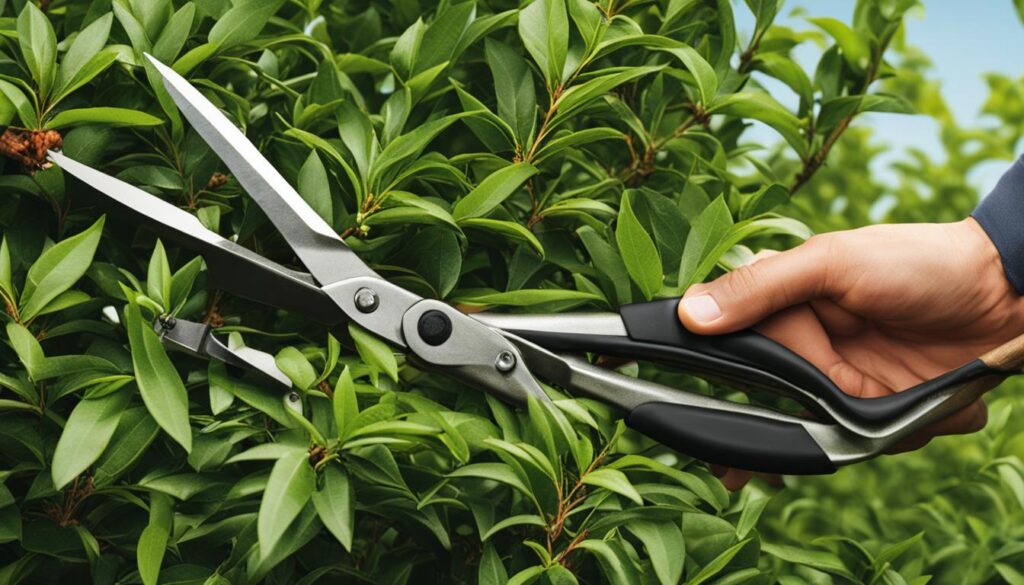Welcome to our guide on the best practices for pruning tea bushes! As tea enthusiasts, we understand the importance of maintaining the health and appearance of your tea plants through proper pruning techniques. Pruning is a vital aspect of tea bush management, helping to improve plant health and quality while maximizing productivity. In this article, we will explore the various methods and considerations for successful tea bush pruning.
Key Takeaways:
- Select the right plants for your tea garden to minimize the need for pruning.
- Prune with a clear plan and in the right season to avoid damage.
- Choose the appropriate pruning technique based on your tea bush’s growth pattern and garden goals.
- Timing is crucial – prune during the dormant period to minimize stress on the plant.
- Use the correct pruning tools for efficient and effective results.
Reasons for Pruning Tea Bushes
Tea bushes are pruned for several reasons, each contributing to the overall health and productivity of the plants. One of the primary reasons for pruning tea bushes is to train them to a desired shape. By selectively removing branches, tea growers can create a well-defined structure that promotes even growth and ease of maintenance.
Pruning also plays a crucial role in improving plant health. By removing dead or diseased branches, tea growers can prevent the spread of infections and ensure the vitality of the plants. Additionally, pruning helps enhance the quality of flowers, fruits, foliage, and stems. By selectively removing certain parts of the tea bushes, growers can encourage the growth of healthier, more vibrant plant components.
Another important reason for tea bush pruning is to restrict excessive growth. By controlling the size and shape of the plants, growers can optimize space utilization and create a more efficient tea garden. Pruning also allows for better airflow and sunlight penetration, which reduces the risk of pest infestations and diseases.
Overall, tea bush pruning is a vital practice in the tea industry, serving to train plants, improve plant health, enhance flower and fruit quality, and restrict excessive growth. By implementing proper pruning techniques, tea growers can maintain healthy and productive tea gardens, resulting in high-quality tea leaves.
Different Pruning Techniques for Tea Bushes
Tea bushes require different pruning techniques depending on the desired outcome. Understanding each technique and its purpose can help tea growers effectively maintain their tea gardens. Here are the various pruning techniques commonly used:
1. Light Pruning
Light pruning involves the removal of excess growth to maintain the desired shape of the tea bushes. This technique helps in controlling the size and appearance of the plants while promoting better airflow and sunlight penetration. Light pruning is typically done by selectively trimming the outer branches and removing any dead or diseased parts. It is suitable for tea gardens where the bushes are well-maintained and require minimal intervention.
2. Medium Pruning
Medium pruning is performed to reduce the height of the tea bushes and remove unproductive branches. This technique helps manage the size of the plants and encourages the growth of new shoots. It is essential for rejuvenating older tea bushes and maintaining their productivity. Medium pruning is typically done during the dormant season when the plants are not actively growing. The goal is to create a balanced canopy that allows for sufficient airflow and sunlight exposure.
3. Skiffing
Skiffing is a lighter form of pruning that focuses on removing congestion within the tea bushes. It involves selectively thinning out overlapping branches to improve the overall health and vigor of the plants. Skiffing helps reduce the risk of pests and diseases by providing better airflow and sunlight to the inner parts of the bushes. This technique is commonly used in tea gardens where the bushes have become overcrowded or when there is a need for better light penetration.
4. Heavy Pruning
Heavy pruning is reserved for situations where there is a decline in tea yield or when rejuvenation is necessary. This technique involves cutting the tea bushes down to a specific height, usually close to the ground. Heavy pruning stimulates the growth of new shoots and encourages the development of more productive branches. It is a significant intervention that should be carefully planned and executed, considering the specific requirements of the tea garden and the growth pattern of the tea cultivar.
By employing the appropriate pruning technique for their tea bushes, growers can maintain healthy and productive plants.
| Pruning Technique | Objective |
|---|---|
| Light Pruning | Maintain shape, improve airflow, and sunlight penetration |
| Medium Pruning | Reduce height, rejuvenate older bushes, manage size |
| Skiffing | Remove congestion, improve health and vigor |
| Heavy Pruning | Stimulate growth, rejuvenate, improve yield |
Pruning and the Pruning Cycle for Tea Bushes
Timing plays a crucial role in tea bush pruning. To maximize the benefits of pruning and minimize stress on the plants, it is best to prune during the dormant period, which is usually in late winter or early spring before the start of the growth season. Pruning during this time allows the bushes to recover quickly and promotes healthy growth.
The interval between two pruning sessions is known as the pruning cycle. The length of the pruning cycle can vary depending on various factors, including the growth pattern of the tea cultivar, soil and climatic conditions, and the specific goals of the tea garden. Some gardens follow an annual pruning cycle, while others may prune every two or three years. It is important to consider the specific needs and characteristics of each tea garden when determining the pruning schedule.
The timing of tea bush pruning is crucial for maintaining a manageable plucking table and promoting the overall health and productivity of the plants. By pruning at the right time and following a regular pruning schedule, tea growers can ensure that their bushes continue to yield high-quality leaves and remain in optimal condition.
| Timing | Key Considerations |
|---|---|
| Late winter or early spring | Prune during the dormant period to minimize stress on the plants and promote healthy growth. |
| Annual or every two to three years | Establish a pruning cycle based on the growth pattern of the tea cultivar, soil and climatic conditions, and the specific goals of the tea garden. |

Proper timing of tea bush pruning is essential for maintaining the health and productivity of the plants. By following a regular pruning schedule and considering the specific needs of each tea garden, growers can ensure that their bushes thrive and continue to produce high-quality tea leaves.
Pruning Tools for Tea Bushes
When it comes to pruning tea bushes, having the right tools is essential for achieving optimal results. Here are some of the key tools that tea growers rely on:
- Hand Pruning Shears: These versatile shears are perfect for cutting stems up to 1/2 inch in diameter. With their sharp blades and ergonomic design, hand pruning shears provide precision and control in shaping tea bushes.
- Lopping Shears: For thicker branches, lopping shears are the tool of choice. With their long handles and powerful cutting blades, lopping shears make it easy to prune larger branches effectively and efficiently.
- Pole Pruners: When it comes to reaching higher branches without the need for a ladder, pole pruners are indispensable. These tools consist of a pole with a cutting head at the end, allowing tea growers to trim branches at various heights.
- Pruning Knife: For finer pruning tasks and precision cuts, a pruning knife is often the go-to tool. With its sharp, narrow blade, a pruning knife is perfect for delicate pruning, such as removing unwanted buds or making intricate cuts.
Having the right pruning tools not only makes the job easier but also ensures that the pruning process is done properly, minimizing damage and promoting the overall health of the tea bushes.
“Using the correct pruning tools is essential for successful pruning. Hand pruning shears, lopping shears, pole pruners, and a pruning knife are some of the key tools that tea growers rely on to maintain the health and productivity of their tea gardens.” – Tea Grower
Remember, it’s important to select tools that are sharp, easy to handle, and suitable for the size and thickness of the branches being pruned. Additionally, proper care and maintenance of the pruning tools are necessary to ensure their longevity and performance. Regularly cleaning and sharpening the blades will help keep them in top condition for years to come.

Table: Comparison of Tea Bush Pruning Tools
| Pruning Tool | Function | Key Features |
|---|---|---|
| Hand Pruning Shears | Cutting stems up to 1/2 inch in diameter | Sharp blades, ergonomic design |
| Lopping Shears | Cutting thicker branches | Long handles, powerful cutting blades |
| Pole Pruners | Reaching higher branches without a ladder | Pole with a cutting head at the end |
| Pruning Knife | Finer pruning tasks, precision cuts | Sharp, narrow blade |
Impact of Pruning on Tea Yield and Plant Health
Pruning plays a crucial role in influencing the yield and overall health of tea bushes. When done correctly, pruning can have a positive impact on tea production and the well-being of the plants. By removing old and unproductive branches, pruning stimulates the growth of new shoots, which are vital for tea yield. It also helps improve the airflow and sunlight penetration within the tea bushes, which are essential for plant health.
Proper pruning techniques can rejuvenate tea bushes, promoting their longevity and productivity. Regular pruning prevents the bushes from becoming overgrown and helps maintain an optimum plucking table, ensuring that the leaves are easily accessible for harvesting. Pruning also aids in managing pests and diseases by eliminating infected or weakened branches. It is important to note, however, that excessive or improper pruning can have negative effects on tea bushes, such as stunting growth or causing damage to the plants.
Effects of Pruning on Tea Bushes
Pruning has various effects on tea bushes, including:
- Stimulating the growth of new shoots and promoting a balanced structure
- Improving airflow and sunlight exposure, reducing the risk of fungal diseases
- Enhancing the quality of tea leaves by removing old or damaged foliage
- Managing the size and shape of tea bushes for easier plucking
Overall, pruning is a crucial practice that contributes to the overall health and productivity of tea gardens. By following proper pruning techniques and considering the specific needs of each tea garden, growers can maintain healthy bushes and achieve optimal tea yield.
Table: Comparison of Pruning Effects on Tea Bushes
| Effect | Positive Impact | Negative Impact |
|---|---|---|
| Growth Stimulation | Promotes the growth of new shoots | Risk of stunting growth if excessive pruning |
| Airflow and Sunlight | Improves ventilation and sunlight exposure | Potential for sunburn or damage to leaves if excessive pruning |
| Leaf Quality | Removes old or damaged foliage, enhancing leaf quality | Potential loss of healthy foliage if excessive pruning |
| Size and Shape | Allows for easier plucking and management | Potential deformation or damage if excessive pruning |
It is crucial for tea growers to find the right balance when pruning their tea bushes, considering factors such as the specific tea cultivar, growth patterns, and desired yield. By implementing appropriate pruning techniques, tea growers can maximize tea yield, enhance plant health, and create thriving tea gardens.
Conclusion
In conclusion, tea bush pruning is a vital practice for maintaining the health and productivity of tea gardens. By following the best practices for tea pruning, we can ensure that our tea bushes thrive and consistently produce high-quality tea leaves.
One of the key aspects of successful tea bush pruning is selecting the right plants for the location. By choosing tea cultivars that are well-suited to the specific climate and soil conditions, we can minimize the need for excessive pruning. This helps to maintain the overall health of the plants and reduces the risk of deformities or weakened growth.
It is also crucial to have a clear plan and understanding of the objectives of pruning. By identifying the specific goals of our tea garden, whether it be training the plants to a desired shape or improving flower and fruit quality, we can tailor our pruning techniques accordingly. Regular pruning, done at the right time of the pruning cycle, helps maintain a manageable plucking table and promotes the rejuvenation of older bushes.
In addition, using the correct pruning tools is essential for effective pruning. Hand pruning shears, lopping shears, pole pruners, and pruning knives are all valuable tools in our arsenal. Ensuring that these tools are sharp, well-maintained, and suited for the size and thickness of the branches being pruned is crucial for achieving clean and precise cuts.
By implementing these best practices, we can maintain the health and vitality of our tea gardens, ensuring a bountiful harvest and a thriving ecosystem. So let’s prune our tea bushes with care and attention, and enjoy the many benefits of a well-maintained tea garden.
FAQ
Why is proper pruning important for tea bushes?
Proper pruning is crucial for the health and appearance of tea bushes. It helps maintain plant health, improve quality, and prevent deformities or weakness in the plants.
What are the reasons for pruning tea bushes?
Tea bushes are pruned for several reasons, including training the plant to a desired shape, maintaining plant health, improving flower and fruit quality, and restricting excessive growth.
What are the different pruning techniques for tea bushes?
There are various pruning techniques for tea bushes, including light pruning to maintain shape, medium pruning to reduce height and remove unproductive branches, skiffing to improve overall health, and heavy pruning to cut the plant down to a specific height.
When is the best time to prune tea bushes?
The best time to prune tea bushes is usually in late winter or early spring, before the start of the growth season. Pruning during the dormant period minimizes stress on the plant.
What tools should be used for pruning tea bushes?
The tools commonly used for pruning tea bushes include hand pruning shears for smaller stems, lopping shears for thicker branches, pole pruners for reaching higher branches, and pruning knives for finer pruning tasks.
How does pruning impact tea yield and plant health?
Proper pruning techniques can help maintain a balanced and productive growth of tea plants, resulting in higher yields. It improves airflow, sunlight exposure, and prevents the spread of pests and diseases.





